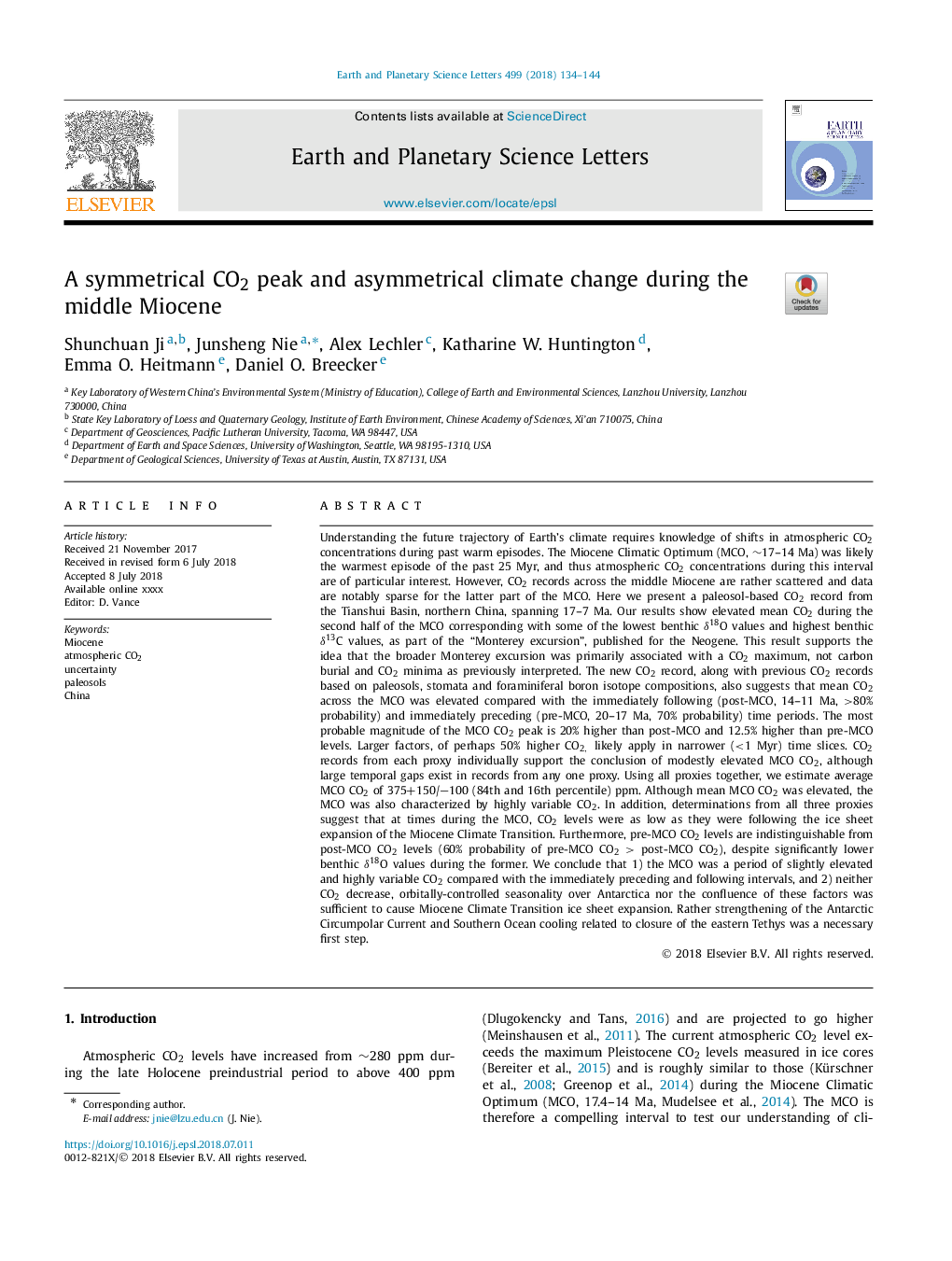| کد مقاله | کد نشریه | سال انتشار | مقاله انگلیسی | نسخه تمام متن |
|---|---|---|---|---|
| 8906685 | 1634657 | 2018 | 11 صفحه PDF | دانلود رایگان |
عنوان انگلیسی مقاله ISI
A symmetrical CO2 peak and asymmetrical climate change during the middle Miocene
دانلود مقاله + سفارش ترجمه
دانلود مقاله ISI انگلیسی
رایگان برای ایرانیان
کلمات کلیدی
موضوعات مرتبط
مهندسی و علوم پایه
علوم زمین و سیارات
علوم زمین و سیاره ای (عمومی)
پیش نمایش صفحه اول مقاله

چکیده انگلیسی
Understanding the future trajectory of Earth's climate requires knowledge of shifts in atmospheric CO2 concentrations during past warm episodes. The Miocene Climatic Optimum (MCO, â¼17-14 Ma) was likely the warmest episode of the past 25 Myr, and thus atmospheric CO2 concentrations during this interval are of particular interest. However, CO2 records across the middle Miocene are rather scattered and data are notably sparse for the latter part of the MCO. Here we present a paleosol-based CO2 record from the Tianshui Basin, northern China, spanning 17-7 Ma. Our results show elevated mean CO2 during the second half of the MCO corresponding with some of the lowest benthic δ18O values and highest benthic δ13C values, as part of the “Monterey excursion”, published for the Neogene. This result supports the idea that the broader Monterey excursion was primarily associated with a CO2 maximum, not carbon burial and CO2 minima as previously interpreted. The new CO2 record, along with previous CO2 records based on paleosols, stomata and foraminiferal boron isotope compositions, also suggests that mean CO2 across the MCO was elevated compared with the immediately following (post-MCO, 14-11 Ma, >80% probability) and immediately preceding (pre-MCO, 20-17 Ma, 70% probability) time periods. The most probable magnitude of the MCO CO2 peak is 20% higher than post-MCO and 12.5% higher than pre-MCO levels. Larger factors, of perhaps 50% higher CO2, likely apply in narrower (<1 Myr) time slices. CO2 records from each proxy individually support the conclusion of modestly elevated MCO CO2, although large temporal gaps exist in records from any one proxy. Using all proxies together, we estimate average MCO CO2 of 375+150/â100 (84th and 16th percentile) ppm. Although mean MCO CO2 was elevated, the MCO was also characterized by highly variable CO2. In addition, determinations from all three proxies suggest that at times during the MCO, CO2 levels were as low as they were following the ice sheet expansion of the Miocene Climate Transition. Furthermore, pre-MCO CO2 levels are indistinguishable from post-MCO CO2 levels (60% probability of pre-MCO CO2 > post-MCO CO2), despite significantly lower benthic δ18O values during the former. We conclude that 1) the MCO was a period of slightly elevated and highly variable CO2 compared with the immediately preceding and following intervals, and 2) neither CO2 decrease, orbitally-controlled seasonality over Antarctica nor the confluence of these factors was sufficient to cause Miocene Climate Transition ice sheet expansion. Rather strengthening of the Antarctic Circumpolar Current and Southern Ocean cooling related to closure of the eastern Tethys was a necessary first step.
ناشر
Database: Elsevier - ScienceDirect (ساینس دایرکت)
Journal: Earth and Planetary Science Letters - Volume 499, 1 October 2018, Pages 134-144
Journal: Earth and Planetary Science Letters - Volume 499, 1 October 2018, Pages 134-144
نویسندگان
Shunchuan Ji, Junsheng Nie, Alex Lechler, Katharine W. Huntington, Emma O. Heitmann, Daniel O. Breecker,